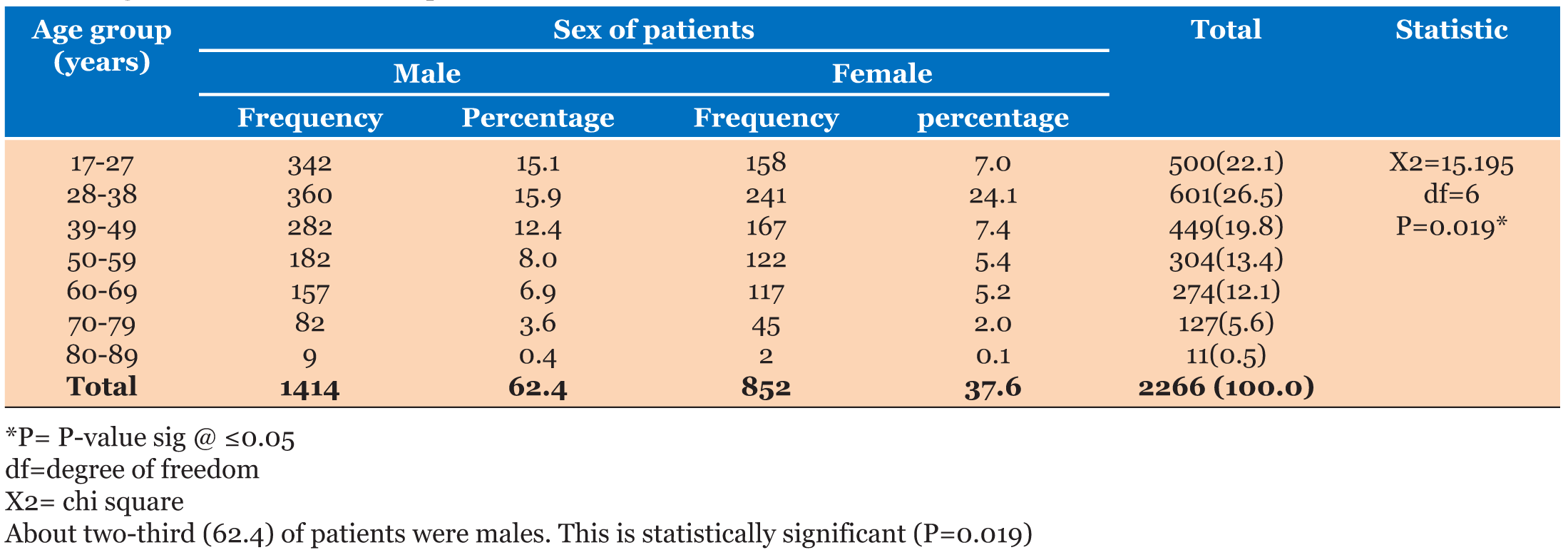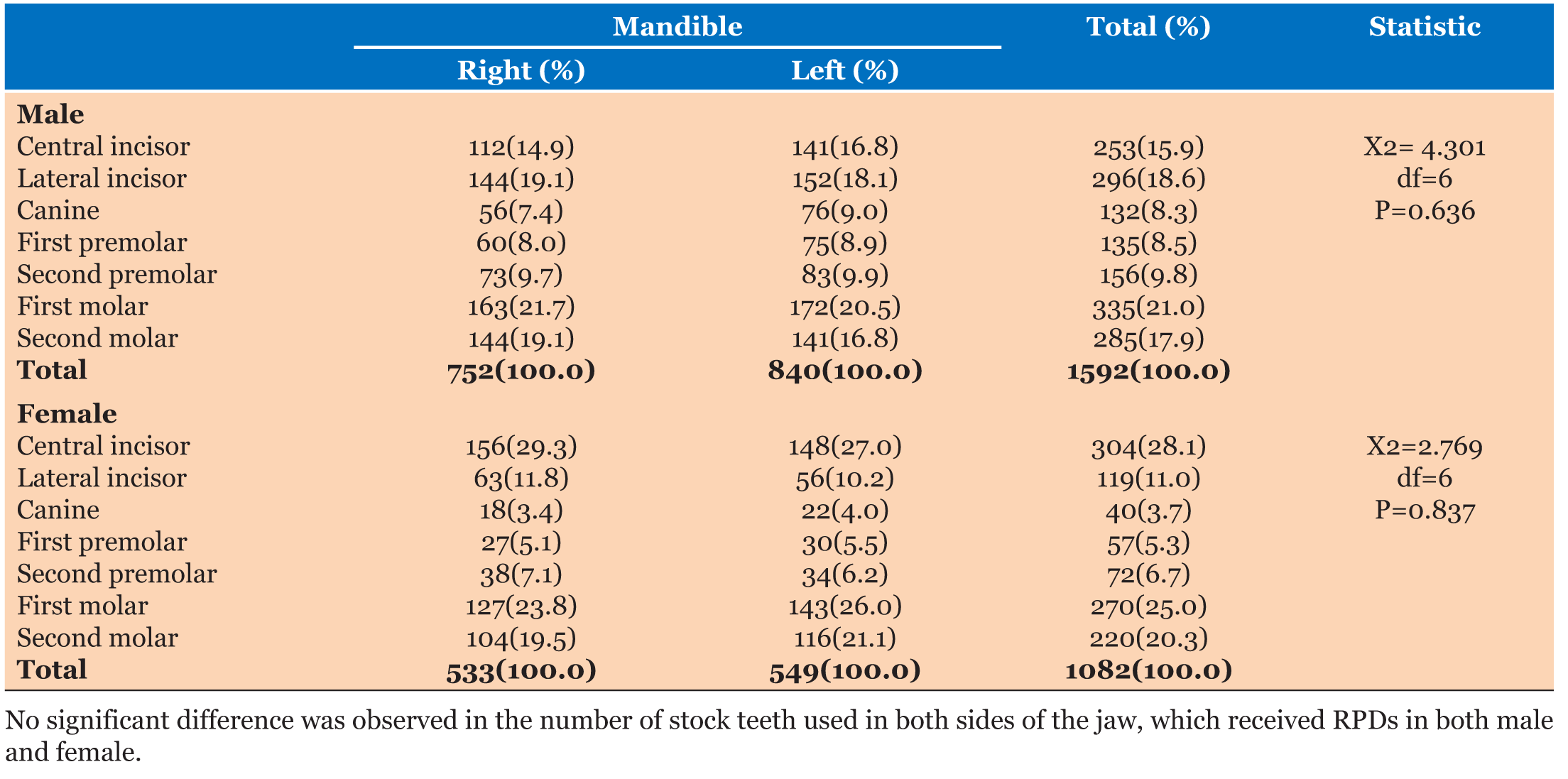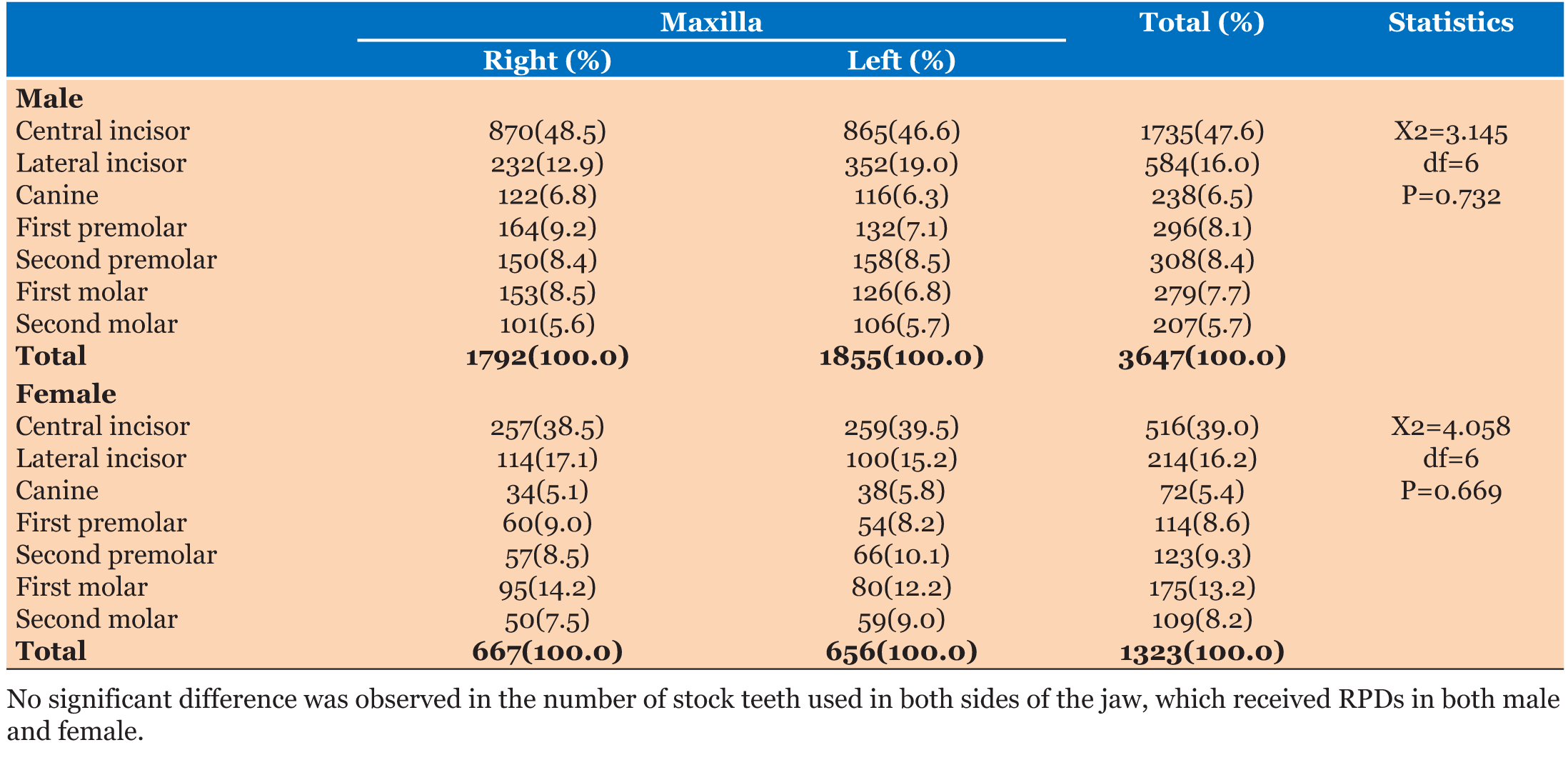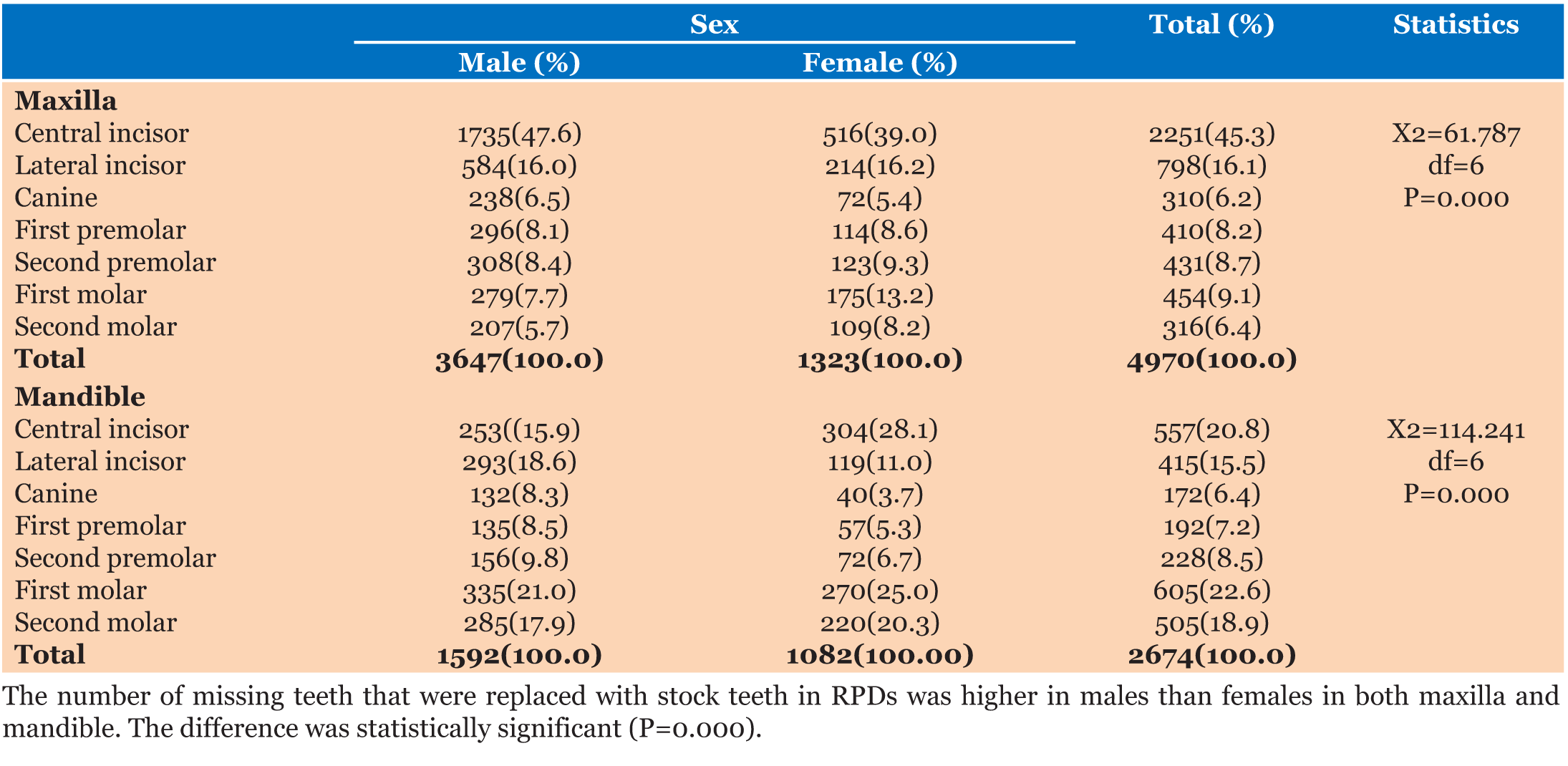 |
Original Article
Relative frequency and pattern of usage of stock teeth in removable partial dentures in a clinical setting in Nigeria
1 Lecturer 1, Department of Restorative Dentistry, College of Medicine Lagos State University, Ikeja, Lagos state, Nigeria
2 Senior Lecturer, Department of Restorative Dentistry, College of Medicine Lagos State University, Ikeja, Lagos state, Nigeria
Address correspondence to:
Olugbenga Adetokunbo Adenuga-T
Lagos State University College of Medicine, Faculty of Dentistry, 1-5 Oba Akinjobi Way G.R.A, Ikeja, Lagos State, P.M.B 21266,
Nigeria
Message to Corresponding Author
Article ID: 100033D01OT2018
Access full text article on other devices

Access PDF of article on other devices

How to cite this article
Adenuga-Taiwo OA, Loto AO, Awotile AO, Menakaya IN. Relative frequency and pattern of usage of stock teeth in removable partial dentures in a clinical setting in Nigeria. Edorium J Dent 2018;5:100033D01OT2018.ABSTRACT
Aims: The current study was designed to determine the frequency of usage of acrylic stock teeth in RPDs using variables such as age, gender, jaw quadrants and jaws respectively.
Methods: This random retrospective study reviewed the laboratory cards of 2,266 adult patients who requested for RPDs from the Dental Centre of Lagos State University Teaching Hospital, Ikeja, Lagos, Nigeria. Data on the frequency of usage of stock teeth relative to the sides of each jaw as well as both jaws, age and gender were recorded and analysed.
Results: There were 2,774 acrylic partial dentures supplied during the period of study. Males (67.7%) used upper dentures compared to females (59.4%); and more females (40.6%) requested for lower dentures as against 32.3% males. A decline in the number of teeth replaced was seen progressively towards the posterior region of each jaw. No marked difference was seen between the distribution of teeth provided for the right and left sides of each jaw. There were more acrylic stock teeth demanded for the upper jaw compared to the lower jaw.
Conclusion: The request for RPDs was more in females than males; though, more use of acrylic stock teeth were seen in males compared to females. There was no marked difference between the distribution of teeth provided for the right and left sides of each jaw. More acrylic teeth were used in the upper jaw compared to the lower jaw.
Keywords: Acrylic stock teeth, Clinical setting, Removable partial denture
INTRODUCTION
Removable partial denture (RPD) is a type of prosthesis used to replace missing teeth in partial edentulous patients. It is a common prosthodontic treatment for patients in the south western region of Nigeria. Recent investigations analysed the trends in demand for prosthodontic treatment in the United States and found that as the full edentulous condition decreases, the use of removable partial dentures (RPD) increases [1],[2]. Similarly, as the rate of total tooth loss decreases, the need for removable partial denture treatment increases [3],[4],[5]. In addition, it was found that with the improved level of awareness of preventive oral care, there has been an increase in the number of patients who require prosthodontic treatment with RPDs [6],[7],[8]. However, other treatment options to replace missing teeth include the use of conventional fixed bridge, resin-bonded bridge, and implant–retained prosthesis [1]. These treatment options are found to be expensive especially in the low socio-economic areas where highest rate of tooth loss occur and may limit their demand for them [9],[10],[11].
It has also been observed that there is greater demand and provision of acrylic resin based RPDs than cobaltchromium based RPDs because they are more affordable to patients [2] as well as the possibility of altering the acrylic prosthesis should further tooth loss occurs [10].
Consequently, in many developing countries, the construction of acrylic denture is a popular treatment option based on its cost effectiveness and easy availability. To this end, the most important reason why patients seek prosthetic replacement of missing teeth is to improve their appearance [3],[10]. However, other reasons include the restoration of speech, mastication, confidence and psychological well-being.
Furthermore, the effect of age and sex on the demand for RPDs have been investigated [9], but the influence of social status on the pattern of demand and other major reasons are yet to be fully investigated in our environment [7]. Provision of RPD is often initiated by patient’s demand [4]. However, it is not clear sometimes, why patients who are in need of prostheses do not care while those who are not necessarily indicated requested for them [11]. The aim of this study was to determine the frequency and distribution pattern of stock teeth in the provision of RPDs with a view of having a better understanding of budgeting, purchasing and stocking of acrylic teeth.
MATERIALS AND METHODS
The data for this study were collected by retrospectively reviewing laboratory cards/records of patients who were treated at Lagos State University Teaching Hospital (LASUTH) dental laboratory between 2011 and 2014. The study parameters included: patients’ ages, distribution of stock teeth in frequency and percentage with respect to gender, jaw/jaw quadrants and tooth type, distribution of RPD in frequency and percentage according to sex and jaw location of replaced teeth.
The inclusion criteria include: the anonymity and confidentiality of the patients whose laboratory records were employed for the study; indication of the missing tooth/teeth to be replaced on the laboratory cards; and evidence of delivery of the RPDs to the patients, which must be shown on the laboratory cards.
The exclusion criteria cover patients that were less than 17 years of age or patients whose work authorisation forms contained less information and those that demanded for complete dentures, denture repairs, over denture, transitional and fixed partial dentures.
The obtained data were presented in tabular forms; and managed on Computerized SPSS Window version 20.0 (SPSS Inc. Chicago Illinois, USA) to generate descriptive statistics (frequency, percentage, mean, SD).
Comparisons of relative usage of stock teeth with respect to the study parameters were carried out using Chi Square Test (X2). In addition, the results of the current study were also statistically compared with other local studies [6],[7].
RESULTS
A total of 2,266 patients received removable partial dentures (RPDs) during the four year study period. Among these patients, 1,414(62.4%) were males and the remaining 852(37.6%) were females. The ages of patients (n) ranged from 17 to 89 years (Mean± SD=1.26) and median age was 35 years. The age group 28-38 years was the most frequently affected and this was followed closely by age group 17-27 years (Table 1).
Regarding the frequency of usage of removable prostheses, a total of 2,774 (100%) RPDs were supplied; and greater number of males (61.5%) used dentures than females (38.4%). In both sexes, there was a significantly higher usage of RPDs in the upper jaw (1790) compared to the lower jaw (984) while the use RPDs in males were significantly higher than females (Table 2). The results demonstrated that there was no statistically significant difference in the number of stock teeth provided for each side of the jaws in both sexes (Tables 3), (Table 4).
The maxillary central incisors (2,251) (45.3%) were the most principally replaced teeth followed by the maxillary lateral incisors (798) (16.1%) (Table 5). The number of missing teeth that were replaced with stock teeth in RPDs was higher in males than females in both maxilla and mandible. The difference was statistically significant (P=0.000) (Table 5).
A greater number of missing maxillary teeth were replaced with stock acrylic teeth in RPDs compared to the missing mandibular teeth. This was statistically significant (P-value=0.000) (Tables 6), (Table 7). The current study showed that the frequency of replacing missing teeth with stock teeth was higher than other previous Nigerian studies in respect of upper and lower RPDs (Table 8). Finally, the findings of the current study were also comparable with previous Nigerian studies (Table 8).
DISCUSSION
In the present study, more males requested for removable acrylic dentures. This is in agreement with earlier studies carried out in Nigeria [6],[12] where they reported that more males requested for removable prostheses. However, Arigbede and Taiwo [7] in another Nigerian study and Ferreira et al [8] demonstrated a female predominance. This might be attributed to the tendency of females to attend clinics regularly than men owing to their earlier presentation of tooth loss, which could be as a result of underlying periodontal disease aggravated by pregnancy [13].
The higher demand for RPDs in males, according to this study, might be related to the fact that tooth loss, as a result of trauma, is highly prevalent in the male population [14]. Esan et al [9] who observed a significant tooth loss among male commercial motorcyclists (Okada) involved in road traffic accidents in Lagos support this. The most commonly affected age group in this study was 28-38 years; and this was followed by 17- 27 years [15].
In addition, the mean age of patients in this study was 35 years; and it was comparable with the study of Hassan et al [16] who reported 35.5 years but seriously contradicted by Curtis et al [17] who reported mean age of 55 years in their study.
Furthermore, the prevalence of young age groups in this study might be due to the fact that they are more concerned about their appearance; and are economically capable. This study also established the fact that greater use of acrylic stock teeth in the anterior region of the maxilla as compared with the mandible. Aesthetics could also be the driven factor for the greater demand for replacement of anterior teeth compared to the posterior missing teeth.
Consequently, most people would rather wear the upper removable prostheses compared to the lower ones for aesthetic reason; and this is regardless of the sex of the patients.
However, the vulnerability of anterior teeth to trauma and loss had been established by various studies [18],[19],[20],[21], which observed that the most commonly traumatized teeth were the maxillary incisors because of their conspicuous position. The maxillary central incisors were found to be the most replaced teeth, followed by the maxillary lateral incisors and the mandibular incisors in this study. These findings were in agreement with the study carried out in South-South, Nigeria by Arigbede, Taiwo [7]. Canine was the least lost tooth in this study. This might be due to its long, deep and firm root coupled with its position at the angle of the mouth that kept it away from direct frontal impact as well as its low susceptibility to caries.
Moreover, apart from aesthetics particularly in educated and young individuals, speech defect could play a contributory motivating factor in the demand for prosthetic teeth when anterior teeth are missing. The loss of maxillary anterior teeth may prevent clear reproduction of certain sounds, particularly F and V, which are pronounced by the lower lip contacting the edges of the maxillary incisors [22].
The frequency of usage of acrylic stock teeth in the posterior segment was limited in this study and this was supported by previous studies [6],[7]. This pattern of replacement of posterior teeth is expected even in developed countries where spaces in the premolar and molar areas are accepted by people of all ages [23] using the principle of shortened dental arch concept.
The clinical significance of this study is that the findings obtained will assist in making concrete decisions concerning budgeting, purchases and stocking of acrylic teeth for removable partial dentures. This will also prevent wastage of scarce resources and funds.
LIMITATION
Patients were not physically involved in this study. Therefore, the reasons for relative demand for the replacement of the different tooth types could not be ascertained. The socio-economic factors of patients as well as the level of awareness of patients with respect to other forms of tooth replacement could not be determined.
The present study showed that the frequency of usage of acrylic stock teeth in RPDs were more in males than females; and maxillary incisors were more replaced than others. The study suggests that aesthetics, rather than function, might be the dominant factor concerning demand for removable prostheses among the studied patients at LASUTH.
CONCLUSION
There was no marked difference in the distribution of teeth provided for the right and left sides of each jaw. The results of the study also showed that more acrylic stock teeth were demanded for the upper jaw compared to the lower jaw with the exception of first and second upper molars where a lower demand was made compared to the lower counterparts.
REFERENCES
2.
3.
Jones JA, Orner MB, Spiro A 3rd, Kressin NR. Tooth loss and dentures: Patients' perspectives. Int Dent J 2003;53(5 Suppl):327–34.
[Pubmed]

4.
Spielman AI. The birth of the most important 18th century dental text: Pierre Fauchard's Le Chirurgien Dentiste. J Dent Res 2007 Oct;86(10):922–6. [CrossRef]
[Pubmed]

5.
Adams C, Slack-Smith LM, Larson A, O'Grady MJ. Edentulism and associated factors in people 60 years and over from urban, rural and remote Western Australia. Aust Dent J 2003 Mar;48(1):10–4. [CrossRef]
[Pubmed]

6.
7.
8.
Ferreira RC, de Magalhães CS, Moreira AN. Tooth loss, denture wearing and associated factors among an elderly institutionalised Brazilian population. Gerodontology 2008 Sep;25(3):168–78. [CrossRef]
[Pubmed]

9.
Esan TA, Olusile AO, Akeredolu PA, Esan AO. Socio-demographic factors and edentulism: The Nigerian experience. BMC Oral Health 2004 Nov 22;4(1):3. [CrossRef]
[Pubmed]

10.
Wardle J, Haase AM, Steptoe A, Nillapun M, Jonwutiwes K, Bellisle F. Gender differences in food choice: The contribution of health beliefs and dieting. Ann Behav Med 2004 Apr;27(2):107–16. [CrossRef]
[Pubmed]

11.
Dable RA, Yashwante BJ, Marathe SS, Gaikwad BS, Patil PB, Momin AA. Tooth loss: How emotional it is for the elderly in India? Oral Health Dent Manag 2014 Jun;13(2):305–10.
[Pubmed]

12.
13.
Paquette DW. The periodontal infection-systemic disease link: A review of the truth or myth. J Int Acad Periodontol 2002 Jul;4(3):101–9.
[Pubmed]

14.
Macgregor ID. The pattern of tooth loss in a selected population of Nigerians. Arch Oral Biol 1972 Nov;17(11):1573–82.
[Pubmed]

15.
Fasola AO, Nyako EA, Obiechina AE, Arotiba JT. Trends in the characteristics of maxillofacial fractures in Nigeria. J Oral Maxillofac Surg 2003 Oct;61(10):1140–3. [CrossRef]
[Pubmed]

16.
Hassan N, Maliksalman A, Ayub H, Waheedullah K, Azad A. Patterns of partial edentulism among armed forces personnel reporting at Armed Forces Institute of Dentistry, Pakistan. Pak Oral Dent J 2011;31(1):23–8.
[Pubmed]

17.
Curtis DA, Curtis TA, Wagnild GW, Finzen FC. Incidence of various classes of removable partial dentures. J Prosthet Dent 1992 May;67(5):664–7. [CrossRef]
[Pubmed]

18.
Sanya BO, Ng'ang'a PM, Ng'ang'a RN. Causes and pattern of missing permanent teeth among Kenyans. East Afr Med J 2004 Jun;81(6):322–5.
[Pubmed]

19.
Rajab LD. Traumatic dental injuries in children presenting for treatment at the Department of Pediatric Dentistry, Faculty of Dentistry, University of Jordan, 1997–2000. Dent Traumatol 2003 Feb;19(1):6–11. [CrossRef]
[Pubmed]

20.
Marcenes W, al Beiruti N, Tayfour D, Issa S. Epidemiology of traumatic injuries to the permanent incisors of 9-12-year-old school children in Damascus, Syria. Endod Dent Traumatol 1999 Jun;15(3):117–23.
[Pubmed]

21.
Traebert J, Peres MA, Blank V, Böell Rda S, Pietruza JA. Prevalence of traumatic dental injury and associated factors among 12-year-old school children in Florianópolis, Brazil. Dent Traumatol 2003 Feb;19(1):15–8. [CrossRef]
[Pubmed]

22.
23.
Graham R, Mihaylov S, Jepson N, Allen PF, Bond S. Determining [CrossRef]
[Pubmed]

SUPPORTING INFORMATION
Author Contributions
Olugbenga Adetokunbo Adenuga-T - Substantial contributions to conception and design, Acquisition of data, Analysis of data, Interpretation of data, Drafting the article, Revising it critically for important intellectual content, Final approval of the version to be published
Adolphus Odogun Loto - Substantial contributions to conception and design, Acquisition of data, Analysis of data, Interpretation of data, Drafting the article, Revising it critically for important intellectual content, Final approval of the version to be published
Adenike Ololade Awotile - Substantial contributions to conception and design, Acquisition of data, Analysis of data, Interpretation of data, Drafting the article, Revising it critically for important intellectual content, Final approval of the version to be published
Ifeoma Nkiruka Menakaya - Substantial contributions to conception and design, Acquisition of data, Analysis of data, Interpretation of data, Drafting the article, Revising it critically for important intellectual content, Final approval of the version to be published
Guaranter of SubmissionThe corresponding author is the guarantor of submission.
Source of SupportNone
Consent StatementWritten informed consent was obtained from the patient for publication of this study.
Data AvailabilityAll relevant data are within the paper and its Supporting Information files.
Conflict of InterestAuthors declare no conflict of interest.
Copyright© 2018 Olugbenga Adetokunbo Adenuga-Taiwo et al. This article is distributed under the terms of Creative Commons Attribution License which permits unrestricted use, distribution and reproduction in any medium provided the original author(s) and original publisher are properly credited. Please see the copyright policy on the journal website for more information.













